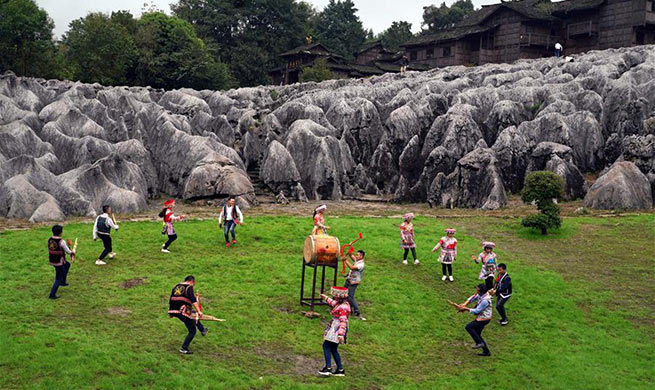BEIJING, Oct. 14 (Xinhua) - Qiangsheng, a Siberian crane whose name literally means "surviving gunshots," is a critically endangered migratory bird species on the IUCN red list.
Nobody had expected that the bird, whose wings and leg were gravely damaged by poachers' bullets, could fly thousands of miles to the Arctic Siberia where the white cranes breed.
Its rescuers never expected Qiangsheng to return to China. But after a few months, it did.
On Wednesday, Qiangsheng was spotted on a monitor, and its tracker data showed that it had come back to the wetland of Xianghai National Nature Reserve in the northeastern province of Jilin, after spending the summer in the Siberian tundra.
"Qiangsheng flew out of the country on May 14, returned to China on Oct. 9 and arrived at Xianghai Reserve at noon on Oct. 10, basically following the same route there and back," said professor Zhou Haixiang, a veteran ornithologist and member of China's State Committee of UNESCO Man and the Biosphere Programme (MAB).
For the Chinese volunteers who have been battling the poachers, the coming back of Qiangsheng was inspiring news ahead of World Migratory Bird Day on Saturday, the second such day within the year.
Even better, Qiangsheng might have participated in breeding activity this year, analyzed an expert based on data collected near the species' breeding areas.
SURVIVING GUNSHOTS
In March this year, Zhou and his team of volunteers found Qiangsheng with three bullet wounds in the wetlands of Liaohe River, in northeastern Liaoning Province.
Its life was hanging by a thread.
The volunteers rushed the bird to Shenyang Predatory Birds Rescue Center, where a four-hour surgery managed to remove the bullets and save its life.
Qiangsheng's wings were shattered and had a broken leg. The volunteers had to bundle together eight of its primary flight feathers to hold its wing in place.
To avoid secondary damage caused by stress responses, Qiangsheng was released into Huanzidong Wetland Reserve in Liaoning shortly after the surgery.
Considering the severity of its wounds, the volunteers thought Qiangsheng would stay at the feeding site for the summer. But after only 50 days of unassisted recovery, it took off with his flock towards the Arctic tundra.
"On May 13, a flock of white cranes departed from Huanzidong Wetland in Faku District, Liaoning, and began their migration. By 5 p.m., the flock flew west by our location in Momoge Wetland," wrote Zhou in his journal.
"Qiangsheng landed 10 km north of us," he wrote, calling it "the white crane whom the volunteers are worried about the most."
Not even the experienced expert had foreseen that the crane, which had barely escaped death, could fly more than 400 km in one day.
FIGHTING POACHING
In the same location that Qiangsheng was found this spring, three other cranes were poisoned by poachers, including one of the only two young chicks of the flock born last year.
The chick and another adult died before rescuers reached them. The other crane was saved and set free a few days later.
After receiving the volunteers' report, Liaoning forest police established a special task force to investigate into the case. A few days later, three suspects were detained.
On Sept. 25, volunteers in Tianjin, a northern port city and important layover site for avian migration, reported two illegal sheds where captured wild birds were forcedly fattened and sold for meat. Over 100,000 birds were found in captivity.
In a matter of days, a joint operative was launched by state and municipal authorities, in which 19,800 law enforcement officers and volunteers conducted inspections of 12,518 risk sites and businesses as of Oct. 4.
China is determined to establish an ecological "red line" by 2020 that will make certain regions protected. Many wildlife experts in China and abroad, including Zhou Haixiang, have urged that wetlands, as a crucial habitat for biodiversity, should be included in the redlined areas to be "under mandatory and rigorous protection."
China plays a fundamental part in the global avian protection given its geographical importance along the East Asian-Australasian Flyway, one of the three major migration paths, experts said.
The Siberian crane, also known as white crane or snow crane, is one of the most threatened of the 15 cranes species remaining on Earth, with an estimated global population of 3,200 as of 2010 and a low reproductive rate.
Every year they fly to breed in the Arctic and spend the winter in warmer wetlands in Asia. They have one of the longest migrations among all cranes.
Their wintering site in Poyang in central China holds approximately 95 to 98 percent of the total population.
"May Qiangsheng fly free and prosper. May no harm ever be done to it or its kin," read a comment on the China Wildlife Conservancy Association's post on the crane's update in May.
















